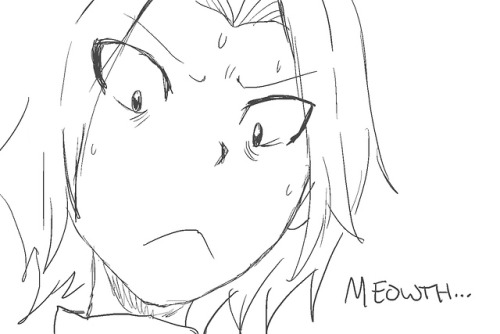To People Who Are Desperately Asking For Fundz/donations On Tumblr.
To people who are desperately asking for fundz/donations on tumblr.
USE THESE REDDIT SUBS INSTEAD PLEASE FOR GOODNESS SAKE!!!!!!!!!
Hate Reddit if you want, but using these subs are your best chance. People gather in these subs because they have charity to spare:
/r/Assistance /r/legaladvice /r/RandomKindness /r/Charity /r/care /r/Random_Acts_Of_Pizza /r/Food_Pantry https://www.reddit.com/r/RandomActsOfPetFood/ https://www.reddit.com/r/RandomActsOfChristmas/ https://www.reddit.com/r/almosthomeless/ https://www.reddit.com/r/homeless
/r/freelance /r/povertyfinance /r/thrifty /r/borrow /r/gofundme
/r/depression /r/familysupport /r/transitions
I never see anyone actually getting any significant donations on tumblr and to be honest, tumblr is the worst place to ask for assistance. Use it as your last resort, it frustrates me to no end seeing people begging for help, reblogging the same post over and over, the same types of posts over and over, to no avail, when people are waiting to help you on a different part of the web GO TO WHERE THE HELP IS. IF YOU WANT DIRECT ACTION TO WORK STOP WITH TUMBLR AND USE REDDIT.
PLEASE FOR THE LOVE OF SATAN REBLOG THIS SO WE CAN START REDUCING THE AMOUNT OF DONATION POSTS THAT GET STUCK FLOATING AROUND THIS WEBSITE
More Posts from Quantumjames and Others
‘am i Having A Brain Problem or Being a Shithead’: a short procrastination checklist
aka why tf am i procrastinating on The Thing (more like a flowchart, actually)
lots of people who have executive function difficulties worry about whether they’re procrastinating on a task out of laziness/simply wanting to be a jerk or mental struggles. this checklist might help you figure out which it is at any given time! (hint: it’s almost never laziness or being a jerk.) (obligatory disclaimer: this is just what works for me! something different might work better for you.)
1) do I honestly intend to start the task despite my lack of success?
yes: it’s a Brain Problem. next question
no: it’s shitty to say one thing & do another. better be honest with myself & anyone expecting me to do the task.
2) am I fed, watered, well-rested, medicated properly, etc?
yes: next question
no: guess what? this is the real next task
3) does the idea of starting the task make me feel scared or anxious?
yes: Anxiety Brain. identify what’s scaring me first.
no: next question
4) do I know how to start the task?
yes: next question
no: ADHD Brain. time to make an order of operations list.
5) do I have everything I need to start the task?
yes: next question
no: ADHD Brain lying to me about the steps again, dangit. first task is ‘gather the materials’.
6) why am i having a hard time switching from my current task to this new task?
i’m having fun doing what i’m doing: it’s okay to have fun doing a thing! if task is time-sensitive, go to next question.
i have to finish doing what i’m doing: might be ADHD brain. can I actually finish the current task or will I get trapped in a cycle? does this task really need to be finished?
the next task will be boring/boring-er than the current task: ADHD brain. re-think the next task. what would make it exciting? what am I looking forward to?
I might not have enough time to complete the task: ADHD brain wants to finish everything it starts. (if task is time-sensitive, go to next question)
i just want to make the person who asked me to do it angry: sounds like anxiety brain trying to punish itself, because I know I’ll be miserable if someone is angry at me. why do i think I deserve punishment?
no, I seriously want to piss them off: okay, i’m being a shithead
7) have I already procrastinated so badly that I now cannot finish the task in time?
yes: ADHD brain is probably caught in a guilt-perfection cycle. since I can’t have the task done on time, i don’t even want to start.
reality check: having part of a thing done is almost always better than none of a thing done. if I can get an extension, having part of it done will help me keep from stalling out until the extension deadline. i’ll feel better if I at least try to finish it.
no, there’s still a chance to finish on time: ADHD brain thinks that I have all the time in the world, but the truth is I don’t.
reality check: if i’m having fun doing what I’m doing, I can keep doing it, but I should probably set a timer & ask someone to check on me to make sure I start doing the task later today.
8) I’ve completed the checklist and still don’t know what’s wrong!
probably wasn’t honest enough with myself. take one more look.
if I’m still mystified, ask a friend to help me talk it out.
hope this helps some of you! YOU’RE DOING GREAT SWEETIE DON’T GIVE UP ON YOU
The median artery is an artery that is occasionally found in humans and other animals. [1] It is present in 35% of individuals born in the late 20th century. [2]
occasionally I'm reminded that biology just sucks to think about
“I was raised Catholic” just translates to “I’m an atheist, but I feel kinda bad about it.”
Does anyone else with autism get that brain thing where their mental dictionary just randomly decides to become unavailable? And all you're left with is describing the word or saying close approximations until someone says it for you?
"The big... Cleaner. In that room."
"The washing machine?"
"YES!"
Words for Skin Tone | How to Describe Skin Color
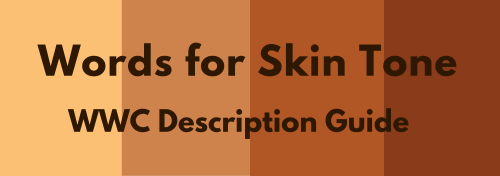
We discussed the issues describing People of Color by means of food in Part I of this guide, which brought rise to even more questions, mostly along the lines of “So, if food’s not an option, what can I use?” Well, I was just getting to that!
This final portion focuses on describing skin tone, with photo and passage examples provided throughout. I hope to cover everything from the use of straight-forward description to the more creatively-inclined, keeping in mind the questions we’ve received on this topic.
Standard Description
Basic Colors

Pictured above: Black, Brown, Beige, White, Pink.
“She had brown skin.”
This is a perfectly fine description that, while not providing the most detail, works well and will never become cliché.
Describing characters’ skin as simply brown or beige works on its own, though it’s not particularly telling just from the range in brown alone.
Complex Colors
These are more rarely used words that actually “mean” their color. Some of these have multiple meanings, so you’ll want to look into those to determine what other associations a word might have.

Pictured above: Umber, Sepia, Ochre, Russet, Terra-cotta, Gold, Tawny, Taupe, Khaki, Fawn.
Complex colors work well alone, though often pair well with a basic color in regards to narrowing down shade/tone.
For example: Golden brown, russet brown, tawny beige…
As some of these are on the “rare” side, sliding in a definition of the word within the sentence itself may help readers who are unfamiliar with the term visualize the color without seeking a dictionary.
“He was tall and slim, his skin a russet, reddish-brown.”
Comparisons to familiar colors or visuals are also helpful:
“His skin was an ochre color, much like the mellow-brown light that bathed the forest.”
Modifiers
Modifiers, often adjectives, make partial changes to a word.The following words are descriptors in reference to skin tone.
Dark - Deep - Rich - Cool
Warm - Medium - Tan
Fair - Light - Pale
Rich Black, Dark brown, Warm beige, Pale pink…
If you’re looking to get more specific than “brown,” modifiers narrow down shade further.
Keep in mind that these modifiers are not exactly colors.
As an already brown-skinned person, I get tan from a lot of sun and resultingly become a darker, deeper brown. I turn a pale, more yellow-brown in the winter.
While best used in combination with a color, I suppose words like “tan” “fair” and “light” do work alone; just note that tan is less likely to be taken for “naturally tan” and much more likely a tanned White person.
Calling someone “dark” as description on its own is offensive to some and also ambiguous. (See: Describing Skin as Dark)
Undertones
Undertones are the colors beneath the skin, seeing as skin isn’t just one even color but has more subdued tones within the dominating palette.
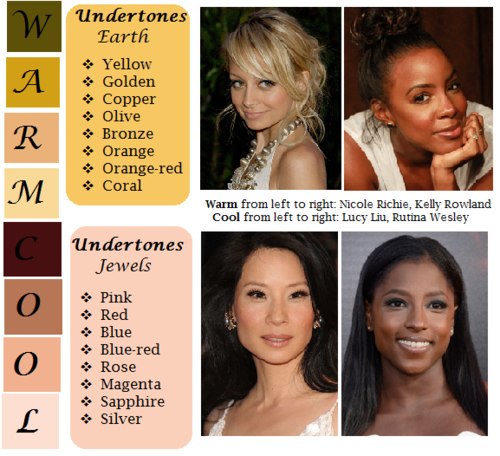
pictured above: warm / earth undertones: yellow, golden, copper, olive, bronze, orange, orange-red, coral | cool / jewel undertones: pink, red, blue, blue-red, rose, magenta, sapphire, silver.
Mentioning the undertones within a character’s skin is an even more precise way to denote skin tone.
As shown, there’s a difference between say, brown skin with warm orange-red undertones (Kelly Rowland) and brown skin with cool, jewel undertones (Rutina Wesley).
“A dazzling smile revealed the bronze glow at her cheeks.”
“He always looked as if he’d ran a mile, a constant tinge of pink under his tawny skin.”
Standard Description Passage
“Farah’s skin, always fawn, had burned and freckled under the summer’s sun. Even at the cusp of autumn, an uneven tan clung to her skin like burrs. So unlike the smooth, red-brown ochre of her mother, which the sun had richened to a blessing.”
-From my story “Where Summer Ends” featured in Strange Little Girls
Here the state of skin also gives insight on character.
Note my use of “fawn” in regards to multiple meaning and association. While fawn is a color, it’s also a small, timid deer, which describes this very traumatized character of mine perfectly.
Though I use standard descriptions of skin tone more in my writing, at the same time I’m no stranger to creative descriptions, and do enjoy the occasional artsy detail of a character.
Creative Description
Whether compared to night-cast rivers or day’s first light…I actually enjoy seeing Characters of Colors dressed in artful detail.
I’ve read loads of descriptions in my day of white characters and their “smooth rose-tinged ivory skin”, while the PoC, if there, are reduced to something from a candy bowl or a Starbucks drink, so to actually read of PoC described in lavish detail can be somewhat of a treat.
Still, be mindful when you get creative with your character descriptions. Too many frills can become purple-prose-like, so do what feels right for your writing when and where. Not every character or scene warrants a creative description, either. Especially if they’re not even a secondary character.
Using a combination of color descriptions from standard to creative is probably a better method than straight creative. But again, do what’s good for your tale.
Natural Settings - Sky

Pictured above: Harvest Moon -Twilight, Fall/Autumn Leaves, Clay, Desert/Sahara, Sunlight - Sunrise - Sunset - Afterglow - Dawn- Day- Daybreak, Field - Prairie - Wheat, Mountain/Cliff, Beach/Sand/Straw/Hay.
Now before you run off to compare your heroine’s skin to the harvest moon or a cliff side, think about the associations to your words.
When I think cliff, I think of jagged, perilous, rough. I hear sand and picture grainy, yet smooth. Calm. mellow.
So consider your character and what you see fit to compare them to.
Also consider whose perspective you’re describing them from. Someone describing a person they revere or admire may have a more pleasant, loftier description than someone who can’t stand the person.
“Her face was like the fire-gold glow of dawn, lifting my gaze, drawing me in.”
“She had a sandy complexion, smooth and tawny.”
Even creative descriptions tend to draw help from your standard words.
Flowers
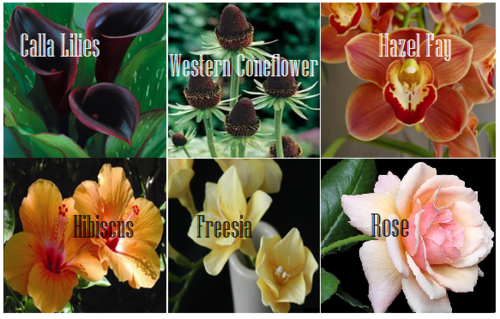
Pictured above: Calla lilies, Western Coneflower, Hazel Fay, Hibiscus, Freesia, Rose
It was a bit difficult to find flowers to my liking that didn’t have a 20 character name or wasn’t called something like “chocolate silk” so these are the finalists.
You’ll definitely want to avoid purple-prose here.
Also be aware of flowers that most might’ve never heard of. Roses are easy, as most know the look and coloring(s) of this plant. But Western coneflowers? Calla lilies? Maybe not so much.
“He entered the cottage in a huff, cheeks a blushing brown like the flowers Nana planted right under my window. Hazel Fay she called them, was it?”
Assorted Plants & Nature

Pictured above: Cattails, Seashell, Driftwood, Pinecone, Acorn, Amber
These ones are kinda odd. Perhaps because I’ve never seen these in comparison to skin tone, With the exception of amber.
At least they’re common enough that most may have an idea what you’re talking about at the mention of “pinecone.“
I suggest reading out your sentences aloud to get a better feel of how it’ll sounds.
"Auburn hair swept past pointed ears, set around a face like an acorn both in shape and shade.”
I pictured some tree-dwelling being or person from a fantasy world in this example, which makes the comparison more appropriate.
I don’t suggest using a comparison just “cuz you can” but actually being thoughtful about what you’re comparing your character to and how it applies to your character and/or setting.
Wood

Pictured above: Mahogany, Walnut, Chestnut, Golden Oak, Ash
Wood can be an iffy description for skin tone. Not only due to several of them having “foody” terminology within their names, but again, associations.
Some people would prefer not to compare/be compared to wood at all, so get opinions, try it aloud, and make sure it’s appropriate to the character if you do use it.
“The old warlock’s skin was a deep shade of mahogany, his stare serious and firm as it held mine.”
Metals

Pictured above: Platinum, Copper, Brass, Gold, Bronze
Copper skin, brass-colored skin, golden skin…
I’ve even heard variations of these used before by comparison to an object of the same properties/coloring, such as penny for copper.
These also work well with modifiers.
“The dress of fine white silks popped against the deep bronze of her skin.”
Gemstones - Minerals
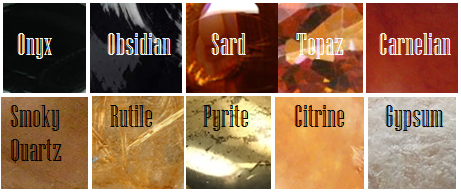
Pictured above: Onyx, Obsidian, Sard, Topaz, Carnelian, Smoky Quartz, Rutile, Pyrite, Citrine, Gypsum
These are trickier to use. As with some complex colors, the writer will have to get us to understand what most of these look like.
If you use these, or any more rare description, consider if it actually “fits” the book or scene.
Even if you’re able to get us to picture what “rutile” looks like, why are you using this description as opposed to something else? Have that answer for yourself.
“His skin reminded her of the topaz ring her father wore at his finger, a gleaming stone of brown, mellow facades.”
Physical Description
Physical character description can be more than skin tone.
Show us hair, eyes, noses, mouth, hands…body posture, body shape, skin texture… though not necessarily all of those nor at once.
Describing features also helps indicate race, especially if your character has some traits common within the race they are, such as afro hair to a Black character.
How comprehensive you decide to get is up to you. I wouldn’t overdo it and get specific to every mole and birthmark. Noting defining characteristics is good, though, like slightly spaced front teeth, curls that stay flopping in their face, hands freckled with sunspots…
General Tips
Indicate Race Early: I suggest indicators of race be made at the earliest convenience within the writing, with more hints threaded throughout here and there.
Get Creative On Your Own: Obviously, I couldn’t cover every proper color or comparison in which has been “approved” to use for your characters’ skin color, so it’s up to you to use discretion when seeking other ways and shades to describe skin tone.
Skin Color May Not Be Enough: Describing skin tone isn’t always enough to indicate someone’s ethnicity. As timeless cases with readers equating brown to “dark white” or something, more indicators of race may be needed.
Describe White characters and PoC Alike: You should describe the race and/or skin tone of your white characters just as you do your Characters of Color. If you don’t, you risk implying that White is the default human being and PoC are the “Other”).
PSA: Don’t use “Colored.” Based on some asks we’ve received using this word, I’d like to say that unless you or your character is a racist grandmama from the 1960s, do not call People of Color “colored” please.
Not Sure Where to Start? You really can’t go wrong using basic colors for your skin descriptions. It’s actually what many people prefer and works best for most writing. Personally, I tend to describe my characters using a combo of basic colors + modifiers, with mentions of undertones at times. I do like to veer into more creative descriptions on occasion.
Want some alternatives to “skin” or “skin color”? Try: Appearance, blend, blush, cast, coloring, complexion, flush, glow, hue, overtone, palette, pigmentation, rinse, shade, sheen, spectrum, tinge, tint, tone, undertone, value, wash.
Skin Tone Resources
List of Color Names
The Color Thesaurus
Skin Undertone & Color Matching
Tips and Words on Describing Skin
Photos: Undertones Described (Modifiers included)
Online Thesaurus (try colors, such as “red” & “brown”)
Don’t Call me Pastries: Creative Skin Tones w/ pics I
Writing & Description Guides
WWC Featured Description Posts
WWC Guide: Words to Describe Hair
Writing with Color: Description & Skin Color Tags
7 Offensive Mistakes Well-intentioned Writers Make
I tried to be as comprehensive as possible with this guide, but if you have a question regarding describing skin color that hasn’t been answered within part I or II of this guide, or have more questions after reading this post, feel free to ask!
~ Mod Colette
It always frustrates me when a toy is hard to customize, because if it's hard to customize, it's hard to repair. Toys shouldn't be single use items imo.
-
 betsybugaboo liked this · 2 weeks ago
betsybugaboo liked this · 2 weeks ago -
 thesmallfriendlytadpole liked this · 2 weeks ago
thesmallfriendlytadpole liked this · 2 weeks ago -
 gerawrd-xd reblogged this · 2 weeks ago
gerawrd-xd reblogged this · 2 weeks ago -
 gerawrd-xd liked this · 2 weeks ago
gerawrd-xd liked this · 2 weeks ago -
 ghostinagarden reblogged this · 2 weeks ago
ghostinagarden reblogged this · 2 weeks ago -
 ghostinagarden liked this · 2 weeks ago
ghostinagarden liked this · 2 weeks ago -
 fischlsdevotedfollower liked this · 2 weeks ago
fischlsdevotedfollower liked this · 2 weeks ago -
 luvquita reblogged this · 2 weeks ago
luvquita reblogged this · 2 weeks ago -
 luvquitashanti reblogged this · 2 weeks ago
luvquitashanti reblogged this · 2 weeks ago -
 revnren reblogged this · 2 weeks ago
revnren reblogged this · 2 weeks ago -
 strawberryfairyflower reblogged this · 2 weeks ago
strawberryfairyflower reblogged this · 2 weeks ago -
 rosethealchemist reblogged this · 2 weeks ago
rosethealchemist reblogged this · 2 weeks ago -
 rosethealchemist liked this · 2 weeks ago
rosethealchemist liked this · 2 weeks ago -
 littlesproutbee liked this · 2 weeks ago
littlesproutbee liked this · 2 weeks ago -
 fluid-by-nature reblogged this · 2 weeks ago
fluid-by-nature reblogged this · 2 weeks ago -
 three-predatory-lesbians reblogged this · 2 weeks ago
three-predatory-lesbians reblogged this · 2 weeks ago -
 three-predatory-lesbians liked this · 2 weeks ago
three-predatory-lesbians liked this · 2 weeks ago -
 lionyacrowroar reblogged this · 2 weeks ago
lionyacrowroar reblogged this · 2 weeks ago -
 auroraambrosia liked this · 2 weeks ago
auroraambrosia liked this · 2 weeks ago -
 eternalparadisearchive reblogged this · 3 weeks ago
eternalparadisearchive reblogged this · 3 weeks ago -
 ac-disastrous liked this · 3 weeks ago
ac-disastrous liked this · 3 weeks ago -
 carmieoverthemoon reblogged this · 3 weeks ago
carmieoverthemoon reblogged this · 3 weeks ago -
 shinjuhakutsuru liked this · 3 weeks ago
shinjuhakutsuru liked this · 3 weeks ago -
 carmieoverthemoon reblogged this · 3 weeks ago
carmieoverthemoon reblogged this · 3 weeks ago -
 existing-apparently liked this · 3 weeks ago
existing-apparently liked this · 3 weeks ago -
 carmieoverthemoon reblogged this · 3 weeks ago
carmieoverthemoon reblogged this · 3 weeks ago -
 lucky-berry reblogged this · 3 weeks ago
lucky-berry reblogged this · 3 weeks ago -
 error84744838 liked this · 3 weeks ago
error84744838 liked this · 3 weeks ago -
 fruitgummyfable liked this · 3 weeks ago
fruitgummyfable liked this · 3 weeks ago -
 fruitgummyfable reblogged this · 3 weeks ago
fruitgummyfable reblogged this · 3 weeks ago -
 olliewolli3 reblogged this · 4 weeks ago
olliewolli3 reblogged this · 4 weeks ago -
 xxcontractdemonxx reblogged this · 4 weeks ago
xxcontractdemonxx reblogged this · 4 weeks ago -
 d3ad-ins1de reblogged this · 4 weeks ago
d3ad-ins1de reblogged this · 4 weeks ago -
 dilf-luvr-4evr reblogged this · 4 weeks ago
dilf-luvr-4evr reblogged this · 4 weeks ago -
 anetdummy liked this · 4 weeks ago
anetdummy liked this · 4 weeks ago -
 heartshapedhooves reblogged this · 4 weeks ago
heartshapedhooves reblogged this · 4 weeks ago -
 aitata-troybel reblogged this · 1 month ago
aitata-troybel reblogged this · 1 month ago -
 aitata-troybel liked this · 1 month ago
aitata-troybel liked this · 1 month ago -
 wingittoodles reblogged this · 1 month ago
wingittoodles reblogged this · 1 month ago -
 i5104 liked this · 1 month ago
i5104 liked this · 1 month ago -
 quietkerfluffle reblogged this · 1 month ago
quietkerfluffle reblogged this · 1 month ago -
 wellwhatthehellme reblogged this · 1 month ago
wellwhatthehellme reblogged this · 1 month ago -
 louloupogi reblogged this · 1 month ago
louloupogi reblogged this · 1 month ago -
 louloupogi liked this · 1 month ago
louloupogi liked this · 1 month ago -
 void-of-erebos reblogged this · 1 month ago
void-of-erebos reblogged this · 1 month ago -
 lemon-tt liked this · 1 month ago
lemon-tt liked this · 1 month ago -
 silent-deydreamer23 reblogged this · 1 month ago
silent-deydreamer23 reblogged this · 1 month ago -
 gabalina97 reblogged this · 1 month ago
gabalina97 reblogged this · 1 month ago




